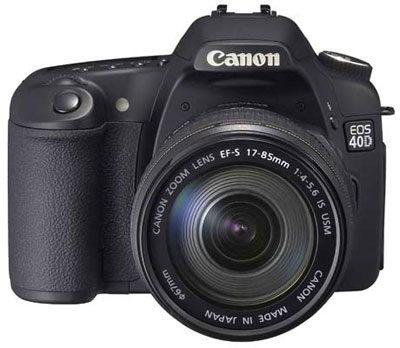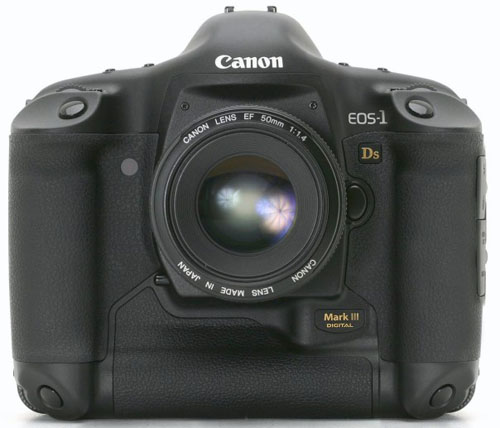NEW! CANON EOS 40D DIGITAL SLR

This week, Canon announced the latest in their series of mid-range digital SLR cameras. The 40D is a modest upgrade and a worthy successor to the 30D
Some of the upgrades include:
A larger sensor, 10 megapixels, up from 8 megapixels in the 30D.
Digic III image processor for improved image quality.
A larger 3.0 inch LCD viewing screen on the back.
Live preview on the LCD. Now you can preview the image on the LCD before clicking the shutter, just like on you favorite digital point-and-shoot.
Improved burst rate and higher capacity buffer. You can capture jpegs at 6.5 frames per second instead of 5 fps on the 30D. Canon claims you can capture 75 images at this rate versus 30 on the 30D.
Dust prevention and cleaning system, just like on the Canon Rebet XT and Canon 1Ds Mark III.
The specifications sound good. Will this new camera live up to expectations? Given Canon's past history, probably, but that isn't a guarantee (see the next paragraph). I will let you know when full reviews with complete tests are available.
As always, I advise you not to buy a camera until a few months after its release. That allows time for bugs to show up, and hopefully, be corrected. That way you won't be burned like the photographers that bought the Canon 1D Mark III which has serious auto-focus problems that have NOT been resolved by the recent firmware update.
You can read more details on the Canon 40D in DP Review's preview article and at Canon's web site.
NEW! CANON EOS 1Ds MARK III

You were planning on selling your car to buy a camera right? That's about what it will take to buy the newly announced Canon EOS 1Ds Mark III when it becomes available.
It's been a long wait. It's predecessor, the EOS 1Ds Mark II was announced nearly 3 years ago.
What's new? This camera has a 21.1 megapixel sensor, up from 16.7 megapixels in the Mark II. It also has the Digic III image processor and the built in dust prevention and cleaning system.
What does this mean? Even bigger images than the huge images the Mark II could produce. For those with the money to spend and the desire to create huge prints from a digital camera with a 35mm sized sensor, this should be pretty close to photographic heaven.
This should be a great camera but that isn't a guarantee (see the next paragraph). I will let you know when full reviews with complete tests are available.
As always, I advise you not to buy a camera until a few months after its release. That allows time for bugs to show up, and hopefully, be corrected. That way you won't be burned like the photographers that bought the Canon 1D Mark III which has serious auto-focus problems that have NOT been resolved by the recent firmware update.
More details on the 1Ds Mark III are in the preview article here.
PERSEID METEOR SHOWER PEAKS TONIGHT - Aug 12-13
The annual mid-August Perseid Meteor shower is usually one of the year's best as the Earth passes through debris left by the comet Swift-Tuttle.
Peak viewing time should be around 3-4 am, EDT, Monday August 13th, but you can begin viewing anytime after dark on August 12. The number of "falling stars" will peak in the early morning hours at one or more per minute or about 60-100 per hour.
The meteor shower will continue for a week or more after August 12-13 but the frequency per hour will drop dramatically. Best viewing will always be after midnight each night.
VIEWING
In the early evening, look east. In mid-evening look northeast. At midnight and later look north and high in the sky. Look around a bit, not just in one direction.
If you live in or near a large city, head north and get away from the big city lights. The darker the sky the better.
A lawn chair that you can lean back in makes for nice viewing. A blanket is nice if it will get chilly.
Use your unaided eyes so you can scan large areas of sky for those momentary streaks of light. Binoculars and telescopes are fine for some night sky viewing but not for a meteor shower.
PHOTOGRAPHY
To photograph the meteors, you need a camera with a bulb setting or long exposure setting, spare batteries, a fast (f/2, f/2.8, or f/4) normal to wide angle lens and fast 200 or 400 speed slide film (like Kodak Elite Chrome 200), or 800 speed negative film, or set your digital camera to ISO 400.
If you use 200 speed slide film set the film speed on the camera for ISO 320 (not 200). When you get your film processed, ask for "PUSH 1" processing. If you use 400 speed slide film, set the camera for 400 and get normal processing.
If you use negative film, use Kodak or Fuji 800 speed film and set your camera film speed at 400 (not 800). Get your film processed normally.
With a digital camera, set the ISO to 400. If your digital camera is known for low noise at high ISOs, set it at ISO 800.
Little dots and streaks of light on film are hard to interpret so give you film processor a break. If you are using a film camera and you are at the beginning of a roll, take a normal picture inside before going out to do meteor pictures. This will be a big help to the person that cuts and mounts your slide film after it is processed, or makes prints from your negative film.
Put a 50mm, 28mm, 24mm or wider lens on your camera and set the aperture to f/2.8 (f4 for zoom lenses) and focus the lens on infinity (turn off autofocus). Put the camera on a tripod (or bean bag), and point it from northeast to north (depending on the time of the evening - see above) and aim high in the sky. Put the camera on bulb, and lock the shutter open for anywhere from 15 seconds to 15 minutes and wait. If you are lucky, one or more meteors will streak through your field of view. Take lots of photos. Have spare batteries. Switch when your "in camera" batteries get tired. Don't discard the tired batteries - warm them in your pocket and they may bounce back.
A wider angle lens means you have more chance of catching meteors, but the light trails will be shorter. Even if you don't catch a meteor, you should get some interesting star trails with the longer exposures. With short exposures the stars should be points rather than trails.
It is best if there are dark skys (no city lights) to the north and east of your location.
Have fun!